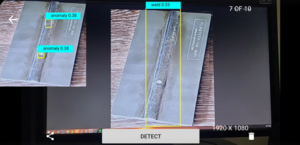
College of Engineering Unit:
Our project provides an application to streamline the process of surveying welds in buildings. Skilled welders are experiencing a shortage of time and unable to keep up with the demand to inspect all buildings. Our application allows welders the opportunity to work remotely by evaluating machine analysis and imagery from a weld surveyor using our application. Streamlining this process keeps us all safe.
Our application requires two machine learning models in order to identify anomalies within a weld. We use YOLOv5 models, machine learning models that are adept at creating bounding boxes around regions of interest in an image, to accomplish our task. One model is trained to recognize an entire weld from a camera feed, the other model predicts whether and where an anomaly exists weld given the result of the first model.
Our android application takes advantage of these models to streamline a weld surveyors task. We use Pytorch for Android and our trained models to detect welds and anomalies in live feed images, as well as images from a gallery. The live feed has the additional benefit of focusing the device’s camera specifically on the weld for more accurate anomaly detection. The application also has the capacity to upload images and annotations to a server, given time for configuration.
In order to improve upon our models performance, our team researched various data augmentation techniques. The YOLOv5 repository has some data augmentation options available by default such as image rotations, reflections, and color filtering. Our team also performed hyperparameter tuning to maximize results from a given dataset.
Lastly, our team also took advantage of the findings from a paper titled Masked Autoencoders Are Scalable Vision Learners. This paper finds that masked autoencoders are capable of reconstructing an original image even with 75% of the image masked in regular, square chunks. Our team uses an implementation of this paper to mask anomalous regions, which results in a non-anomalous reconstruction of the image. These reconstructions improve the results of our anomaly detection model when included in the training dataset.
Industry Sponsor(s):